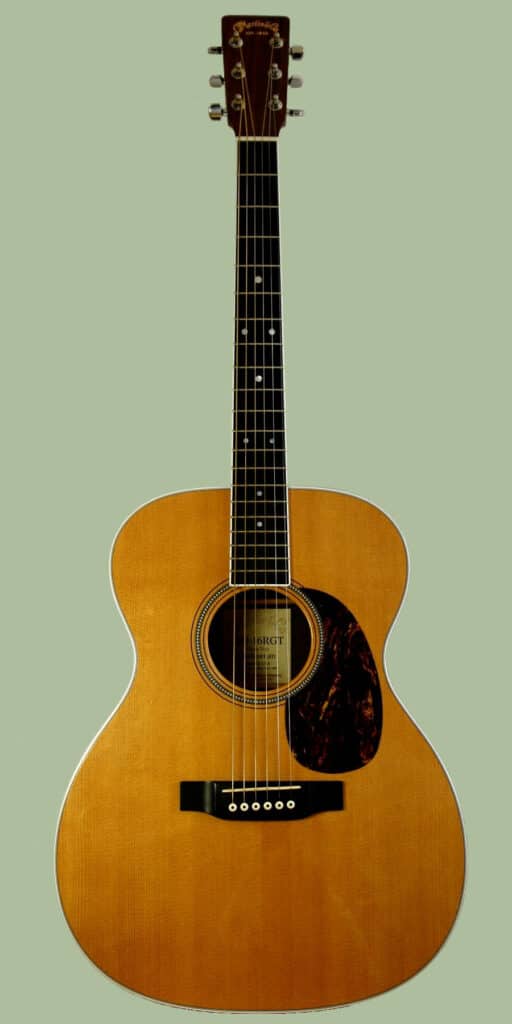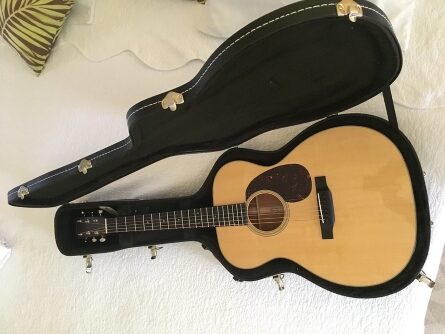
There is an array of guitar manufacturing brands in the market and choosing one can be challenging, especially if you are purchasing a guitar for the first time. The new guitarists need to consider the features, playability, durability, design, sound output, and more.
Martin and Huss and Dalton are two popular US-based companies and it’s common for guitar enthusiasts to become confused between these two. However, understanding the design and quality differences between these two brands is essential to choosing a reliable brand!
Huss and Dalton vs Martin Guitar – The Comparison Table
| Features | Huss and Dalton | Martin |
|---|---|---|
| Origin | 1995 | 1833 |
| Hand Manufacturing | No | Yes |
| Body Material | Red spruce wood | Rosewood or mahogany |
| Price | Affordable | Expensive |
Huss and Dalton vs Martin
Huss and Dalton
This is a popular banjo and acoustic guitar manufacturer based in Staunton, Virginia. The company became operational back in 1995 by Mark Dalton and Luthiers Jeff Huss. The first guitar shop was set up in the Mennonite community but moved to the current location in the year 1999.
According to the company, the company’s founders wanted to create an acoustic guitar that paid tribute to the guitar tradition while improving the appearance and structural design.
Company
The company has been operational since 1995 and they are currently operating on a small scale. In addition, they have a two-story workshop where they produce around 250 instruments a year. They are known for two unique construction styles for designing and manufacturing guitars.
For instance, the standards series are designed with a 25 inches radius of the top of the guitar – it helps create an arch into the braces and prepares the sides within the same radius to complement the soundboard. On the other hand, the traditional series has a 25-inch radius in braces but has flat sides, which leads to a traditional style.
As far as the guitar designs are concerned, they use Martin guitar designs as the base as well as some vintage Gibson guitars. However, there are some significant changes in the guitar designs. In addition to the guitars, the company also manufactures banjos!
Design & Construction
To begin with, the company uses Appalachian red spruce wood braces which results in exceptional top sound. In addition, the braces are extremely stable as compared to untreated and fresh wood. These braces can resist warping, splitting, and cracking.
Secondly, they use Honduras rosewood for manufacturing the bridge plates – this material is hard and stiff and helps coax the guitar’s sound. In addition, it can add crispness and brightness to the tones while improving responsiveness.
There is AAA-grade top wood in the guitar, which improves the tone and resonance of the guitar. In fact, such tops add a snappy sound to the music. As far as the nuts are concerned, they are made from bone and are fully compensated – the material and compensation lead to a longer sustain, fuller tone, and ability to hold the tuning.
A compensated nut is best at improving the tuning consistency as it moves the take-off point a bit forward. As far as the neck is concerned, different types of wood are used depending on the model but the most commonly used woods include mahogany, Spanish cedar, maple, and walnut with a steel truss rod.
The steel truss rod offers exceptional stability to the neck, making it easier to use and preventing warping. Also, the fingerboards are made from ebony, which adds snap or bite to the music. The ebony fingerboards also have a sharper attack but you will need to play down the new strings for a bit to eliminate harshness.
The company uses ebony or white binding to bind the fingerboards, which does a great job at hiding the fret ends. In addition, there are quarter-sawn woods in every guitar as they help prevent wear and tear, swelling, shrinking, splitting, and twisting.
The quarter-sawn woods also make a great painting surface. Last but not least, they have a bigger soundhole like Gibson and Martin.
Martin
Purchasing a Martin guitar is every guitarist’s dream as they have something for everyone, including complete beginners and professionals. Martin & Co. is in the guitar manufacturing business for over 200 years now. In particular, the company started in 1833 and Christian Frederick Martin is the founder.
The most surprising fact is that this has been a family business for 6 generations and all their guitars are produced in Nazareth but some series are produced in Mexico as well.
Company
The company started in 1833 and its guitars have been a part of the modern music revolution. Currently, the company is handled by the 7th generation of the family. Martin & Co. is the pioneer of x-bracing, which not only produces a rich sound but strengthens the guitar body as well.
In fact, the dreadnought size was also designed by this company. In addition to manufacturing the guitars, they have a charitable foundation with which they offer nonprofit arts, music, and education support. The company is known for its high-end acoustic guitars.
There are various budget-friendly guitars available that are made from composite material and custom-built guitar models that cost over $20,000. In addition to guitars, they have an array of guitar strings, music accessories, and ukuleles. They have headquarters in Nazareth as well as a manufacturing facility.
However, the road series, PA5 models, X series, dreadnought junior, and backpacker series are manufactured in a Mexico-based plant. Martin & Co. also has a special store where the rejected guitar parts are sold – these parts are suitable for beginners who just want to learn how to play.
Design & Construction
The Martin guitars are designed to offer a bright sound, irrespective of how secluded or crowded the area is. For this purpose, it’s a great choice for rock bands. Since these guitars have a high-end tone, they are perfect for recording sessions. The guitars are easy to mix and can be used with heavy as well as light strings.
Some of the guitars are designed with an electronics system, which improves feedback protection and stable tuning. The company uses high-end solid woods in the high-end guitar models, which results in a louder acoustic tone. In addition, the solid wood has a consistent grain, which delivers rich resonance and improved sustain.
Various high-end models of Martin & Co. are manufactured by hand but those models are more expensive. To date, the company has used mahogany and rosewood in the guitar – the mahogany-based guitars have an earthy yet strong midrange tone, which makes them suitable for playing blues music.
On the other hand, the rosewood-based guitars have a sweet and warm tone. The X series is made from high-press laminate, which is why they can be used in extreme temperatures and resist scratching and wear and tear. Over the years, the company has used Waverly, Grover, and Kluson tuners in the 14-fret guitars.
In addition, the guitar binding is made from wood or white and black PVC. There are Jescar frets, which have a smooth finish and the tight grain promises improved playability. Martin & Co. has designed high-tech bridge pins that reflect the sound energy as they are made from zirconium alloy.
As far as construction is concerned, the company uses computer-aided manufacturing software to cut out the wooden sheets and aluminum – this software creates the 3D models for accurate cutting to reduce the manufacturing time and eliminate waste.
Moreover, the CAM systems are used for cutting the fretboards and necks. Last but not least, they leverage a Plek machine to shape and level the fretboard.
The Bottom Line
On a concluding note, Martin & Co. is a legacy brand as it has been around for two centuries as compared to Huss & Dalton Guitar Company which was founded in 1995.
Martin guitars have exceptional tonal quality and high-end build but are expensive, which is why they are recommended for professional guitarists. On the other hand, Huss & Dalton has more affordable guitars, which are suitable for beginners.



